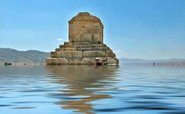Silbury Hill, which at 130 feet high is the largest prehistoric man-made construction in Europe, continues to mystify archaeologists. English Heritage is to spend £600,000 this summer trying to preserve the mound. Specialist engineers will enter the mound through a tunnel which was dug in 1968 by a team led by the archaeologist, Prof Richard Atkinson. That tunnel was the last of three made over two centuries by archaeologists. The original purpose and use of the hill, which is south of the village of Avebury, is still a mystery. Theories suggest it was either a burial mound, a solar observatory or a representation of a Neolithic goddess.
(sounds like a Zoroastrian burial place. bahramerad.)

"It is very unlikely we will ever know why it was built," said Robert Bewley, English Heritage regional director for the South West. "But this project may give us a better idea of when it was built and how it was built. That could provide us with further clues as to why it was built."
On Thursday archaeologists found the small end of an antler outside the tunnel. "This shows they could only use the antlers of deer and pickaxes," Mr Bewley said. "Their tools were very simple so it was a phenomenal achievement to build a mound like that. "We know from Prof Atkinson's investigation there were at least two phases of construction. We hope to clarify how long it took to build the mound, which may have been a generation or more." Engineers yesterday prised open the door of the 1968 tunnel. They will repack every inch of the 40-year-old tunnel as they withdraw to make sure it is stable. A number of craters on the hill will also be refilled. Earlier this year, archaeologists found traces of a Roman settlement at the landmark.
( Gypsies from Persia , Bahramerad.). They believe the site may have been a place of pilgrimage 2,000 years ago.>Mr Bewley said

Roman settlement found next to 'devil's hill' : By Roger Highfield, Science Editor
Evidence of a Roman sacred site has been discovered at the foot of a man-made hill created thousands of years before the Romans arrived in Britain, it was announced yesterday.
Silbury hill: The original purpose and use of the man-made Neolithic hill still mystifies archaeologists . English Heritage called the uncovering of the settlement a "startling discovery", and all the more so because it lies next to 5,000-year-old Silbury hill, which at 130ft is Europe's largest man-made prehistoric monument. The original purpose and use of the Neolithic hill, which took an estimated 20 million man hours to make, still mystifies archaeologists. Yesterday's disclosure indicates that a Roman community was equally taken with the Wiltshire hill and established a sacred settlement in its shadow, some 3,000 years after it was created. The discovery of a settlement the size of 24 football pitches is "quite unexpected" said Dr Amanda Chadburn, an English Heritage archaeologist and team leader. "Although there were hints - the odd Roman coin kicking around - that the Romans were doing something around there we did not know what. This is an important Roman settlement." The site straddled the Roman road from London to Bath where it crossed the Winterbourne River. But it was more than just a way station for weary travellers. The Romans were as intrigued by Silbury as people are today, and there is even a tantalising hint of a temple. "There are a lot of legends about it being built by the devil and you wonder what the Romans thought about it," said Dr Chadburn.

























 اخبار مربوط به زندانیان سیاسی و نقض حقوق بشر
اخبار مربوط به زندانیان سیاسی و نقض حقوق بشر

















 Tulips in Holland
Tulips in Holland












No comments:
Post a Comment